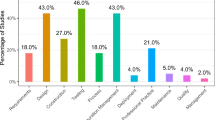Abstract
In the process of software development, software fault prediction is a useful practice to ensure reliable and high quality software products. It plays a vital role in the process of software quality assurance. A high quality software product contains minimum number of faults and failures. Software fault prediction examines the vulnerability of software product towards faults. In this paper, a comparative analysis of various soft computing approaches in terms of the process of software fault prediction is considered. In addition, an analysis of various pros and cons of soft computing techniques in terms of software fault prediction process is also mentioned. The conclusive results show that the soft computing approach has the propensity to identify faults in the process of software development.





Similar content being viewed by others
References
Erturk E, Sezer EA (2015) A comparison of some soft computing methods for software fault prediction. Expert Syst Appl 42(4):1872–1879. Available: http://www.sciencedirect.com/science/article/pii/S0957417414006496
Mockus A, Weiss DM (2002) Predicting risk of software changes. Bell Labs Tech J 5(2):169–180. http://ieeexplore.ieee.org/abstract/document/6772130/
Zadeh LA (1994) Soft computing and fuzzy logic. IEEE Softw 11(6):48–56. http://ieeexplore.ieee.org/abstract/document/329401/
Chaturvedi DK (2008) Soft computing: techniques and its applications in electrical engineering, vol 103. Springer, New York. http://www.springer.com/in/book/9783540774808
Mohanty R, Ravi V, Patra MR (2010) The application of intelligent and soft-computing techniques to software engineering problems: a review. Int J Inf Decision Sciences 2(3):233–272. https://doi.org/10.1504/IJIDS.2010.03345
Chandrasekaran M, Muralidhar M, Krishna CM, Dixit US (2010) Application of soft computing techniques in machining performance prediction and optimization: a literature review. Int J Adv Manuf Technol 46(5–8):445–464. https://doi.org/10.1007/s00170-009-2104-x
Specht DF (1990) Probabilistic neural networks. Neural Netw 3(1):109–118
Honkela T, Kaski S, Lagus K, Kohonen T (1997) WEBSOM—self-organizing maps of document collections. Proc WSOM 97:4–6. https://pdfs.semanticscholar.org/65f7/98edabe8e385647abd384ee8b92ce11a69d1.pdf
Gersho A, Gray RM (2012) Vector quantization and signal compression, vol. 159, Springer Science & Business Media, New York. http://www.springer.com/in/book/9780792391814
Madsen H, Thyregod P, Burtschy B, Albeanu G, Popentiu F (2006) On using soft computing techniques in software reliability engineering. Int J Reliab Qual Saf Eng 13(01):61–72. https://doi.org/10.1142/S0218539306002094
Eiben AE, Schoenauer M (2002) Evolutionary computing. Inf Process Lett 82(1):1–6
Kung SY (2014) Kernel methods and machine learning. Cambridge University Press, Cambridge. https://www.cambridge.org/core/books/kernel-methods-and-machine-learning/4B52092A98E1553A26EB5271D832D29E
Garnier S, Gautrais J, Theraulaz G (2007) The biological principles of swarm intelligence. Swarm Intell 1(1):3–31. https://doi.org/10.1007%2Fs11721-007-0004-y?LI=true
Ardelt M (2004) Wisdom as expert knowledge system: a critical review of a contemporary operationalization of an ancient concept. Hum Dev 47(5):257–285. https://www.karger.com/Article/Abstract/79154
Boccaletti S, Grebogi C, Lai YC, Mancini H, Maza D (2000) The control of chaos: theory and applications. Phys Rep 329(3):103–197
Dempster AP (1967) Upper and lower probabilities induced by a multivalued mapping. Ann Math Stat 38(2):325–339
Neapolitan RE (2012) Probabilistic reasoning in expert systems: theory and algorithms. CreateSpace Independent Publishing Platform, California. https://dl.acm.org/citation.cfm?id=2385835
Ardil E (2010) A soft computing approach for modeling of severity of faults in software systems. Int J Phys Sci 5(2):74–85. http://www.academicjournals.org/journal/IJPS/article-abstract/587073122652
Seliya N, Khoshgoftaar TM, Hulse JV (2010) Predicting faults in high assurance software. In: High-assurance systems engineering (HASE), 2010 IEEE 12th international symposium on, IEEE, pp. 26–34. http://ieeexplore.ieee.org/abstract/document/5634306/
Twala B (2011) Predicting software faults in large space systems using machine learning techniques. Def Sci J 61(4):306–316. http://publications.drdo.gov.in/ojs/index.php/dsj/article/view/1088
Chiu NH (2011) Combining techniques for software quality classification: An integrated decision network approach. Expert Syst Appl 38(4):618–4625
Pelayo L, Dick S (2012) Evaluating stratification alternatives to improve software defect prediction. IEEE Trans Reliab 61(2):516–525. http://ieeexplore.ieee.org/abstract/document/6156808/
Kam J, Dick S (2006) Comparing nearest-neighbour search strategies in the SMOTE algorithm. Can J Electr Comput Eng 31(4):203–210. http://ieeexplore.ieee.org/abstract/document/4028919/
Ramani RG, Kumar SV, Jacob SG (2012) Predicting fault-prone software modules using feature selection and classification through data mining algorithms. In: Computational intelligence & computing research (ICCIC), 2012 IEEE international conference on, IEEE, pp. 1–4. http://ieeexplore.ieee.org/abstract/document/6510294/
Dejaeger K, Verbraken T, Baesens B (2013) Toward comprehensible software fault prediction models using bayesian network classifiers. IEEE Trans Softw Eng 39(2):237–257. http://ieeexplore.ieee.org/abstract/document/6175912/
Chatterjee S, Roy A (2015) Novel algorithms for web software fault prediction. Qual Reliab Eng Int 31(8):1517–1535. https://doi.org/10.1002/qre.1687/full
Goyal R, Chandra P, Singh Y (2014) Suitability of KNN regression in the development of interaction based software fault prediction models. IERI Proc 6:15–21
Arar ÖF, Ayan K (2015) Software defect prediction using cost-sensitive neural network. Appl Soft Comput 33:263–277
Erturk E, Sezer EA (2016) Iterative software fault prediction with a hybrid approach. Appl Soft Comput 49:1020–1033
Chatterjee S, Nigam S, Roy A (2016) Software fault prediction using neuro-fuzzy network and evolutionary learning approach. Neural Comput Appl. https://doi.org/10.1007/s00521-016-2437-y
Dhanajayan RCG, Pillai SA (2017) SLMBC: spiral life cycle model-based Bayesian classification technique for efficient software fault prediction and classification. Soft Comput 21(2):403–415. https://doi.org/10.1007/s00500-016-2316-6
Author information
Authors and Affiliations
Rights and permissions
About this article
Cite this article
Sharma, D., Chandra, P. A comparative analysis of soft computing techniques in software fault prediction model development. Int. j. inf. tecnol. 11, 37–46 (2019). https://doi.org/10.1007/s41870-018-0211-3
Received:
Accepted:
Published:
Issue Date:
DOI: https://doi.org/10.1007/s41870-018-0211-3




